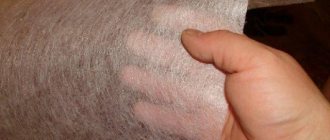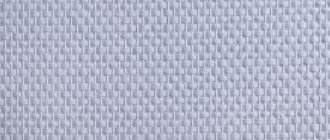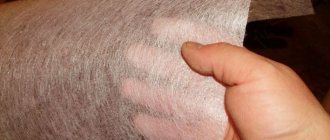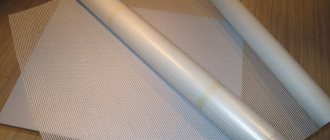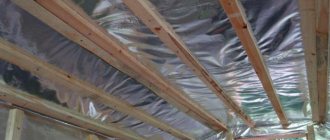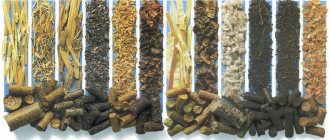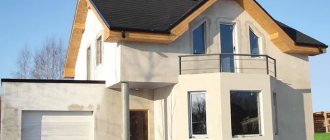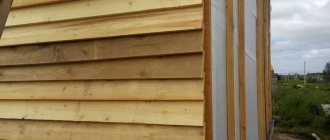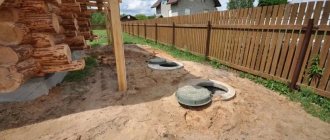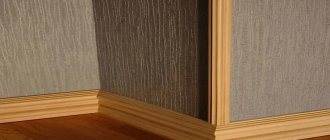Fiberglass-based materials have gained particular popularity in recent years, because they have many advantages. However, in our country people sometimes treat them with caution and believe rumors that glass wallpaper and fiberglass are an analogue of glass wool. In fact, fibers of a different texture are used for their production; they are firmly retained in the coating composition and do not form “glass dust”. In addition, additional protective layers (primer, putty or paint) are applied. In Germany, glass wallpaper is approved for use in kindergartens and hospitals. Isn't this evidence of their safety?
Working with wallpaper
Wallpaper is produced in several categories based on the material of production:
Working with non-woven and glass wallpaper gives a double effect:
- A perfectly smooth wall surface; when painted, defects from the wall surface do not appear on it.
- The walls receive a protective and reinforcing coating, guaranteeing cracks or breaks in the future.
Advice. This is especially important in high-rise apartments, where the seams between the walls are constantly growing. They are simply not visible under the glass wallpaper. Working with glass wallpaper has similar characteristics.
Working with glass wallpaper
As when working with fiberglass, there are several stages:
- Surface preparation (remove old coatings, fill recesses and cracks);
- Priming walls or ceilings;
- Pasting: the canvases are glued end to end, the glue is applied to the wall, as when gluing non-woven wallpaper. Basically, glass wallpaper looks the same on both sides, but manufacturers often apply a gray marking strip on the reverse side. Use only special adhesive for fiberglass materials. The glass wallpaper is painted twice, the layer must dry for at least 12 hours, it is applied 2 days after gluing. To make the wallpaper absorb paint less, they are primed with a diluted glue solution.
Work with glass wallpaper according to the instructions, wearing a respirator, gloves and closed clothing. The most famous manufacturers: Oscar (Russia) - from 2100 rubles per roll, Wellton (Finland) - from 2400 rubles, Tassoglas (Sweden) - from 3200 rubles, Vitrulan (Germany) - from 5000 rubles.
Fiberglass wallpaper is a woven fabric made of glass fibers
Threads are drawn from liquid glass and woven into cloth.
There are two types of glass wallpaper:
The difference between them is only in technology and type of weaving:
- In the first case, the material is similar to ordinary smooth canvas,
- In the second, they are decorated with a certain relief pattern, moreover, they are characterized by greater density than the first.
- Fiberglass is used to strengthen walls and smooth their surfaces.
Note. This procedure is especially often performed in the finishing of ceilings. Here it is easier to glue fiberglass onto its surface than to carry out plastering and putty work.
- The surfaces are perfectly smooth, with a texture reminiscent of marble.
- But they can only look like this if they are painted, and not covered with other wallpaper.
Fiberglass: coating features
Fiberglass wallpaper is a decorative covering that feels like thick fabric. The basis of the material is a special type of fiber (analogue of fiberglass), but they are not only used to make pressed fabric, but also form decorative weaving of various types. This is both a reinforcing and decorative material that will last for several decades, and the paint can be renewed 6-7 times.
The stores offer glass wallpaper of various thicknesses and textures: from primitive zigzags and stripes to floral ornaments and complex patterns. You can apply this wallpaper to any surface: cleaned brickwork, metal, wood, concrete, plastic, chipboard, drywall.
Advantages of glass wallpaper, comparison with non-woven wallpaper
The material is sold in rolls and consists of fiberglass impregnated with a special substance and a backing.
The front side has a clearly defined texture and is intended for further coloring:
- Non-woven wallpaper is considered a good competitor for them in terms of painting.
- A composite paper-like type of finishing material consisting of cellulose and binder in proportions of 70% and 30%, respectively.
Note. Unlike the material in question, the material is pressed rather than woven. Available in the form of non-woven fabric.
Advantages and disadvantages of both types of paintings:
| Glass wallpaper | Non-woven fabric |
| Eco-friendly, completely harmless to humans. | High degree of strength. |
| Resistant to temperature changes, waterproof. | Abrasion resistance. |
| They allow steam and air to pass through. | Fire resistant. |
| Resistant to aggressive detergents. | The adhesive composition is applied to the base of the wall, and not to the canvas. |
| The degree of strength and durability is high. | Does not shrink after drying. |
| Electrostatic | Having a dense base, they hide minor imperfections on the walls or ceiling |
| Easy to care for. | Lets air through. |
| They can be painted multiple times without losing their appearance. | They are washed with special means and belong to the category of washing coatings. |
| Fire resistant because they do not support combustion. | They don't fade, they stick easily. |
Disadvantages of fiberglass and non-woven wallpaper:
| Glass wallpaper | Non-woven |
| High price of material | When using a fabric with a very voluminous texture, dust collects on it. Remove with a vacuum cleaner or dry cloth; do not get them wet. |
| The adhesive composition used is only that intended for liquid wallpaper. | Low resistance to repeated mechanical damage |
| To dismantle the coating you will need a special liquid | The price of the paintings is very high |
Interesting fact! Non-woven wallpaper, in general, is less durable, more susceptible to abrasion, and is less resistant to accidental mechanical damage, unlike glass wallpaper. For this reason, they are not recommended for use in public spaces.
Non-woven fabrics are considered heavy, and they are prone to moisture absorption. For example, due to normal wetness or glue, so the composition cannot be applied to the canvas. The answer to the question: whether to choose non-woven or glass wallpaper is individual for everyone and depends on one’s own preferences and wishes.
Advantage of the material (declared by the manufacturers)
Non-woven fabric for painting is environmentally friendly and does not harm human health, so it can be used in any room. Security explained:
Another plus is the ability to cover surface imperfections, so this is a good option if you intend to paint the walls, glue wallpaper or install other finishing materials.
It helps to create unusual design ideas on the surface using plaster and putty mixtures. In addition, it has tensile strength. It is for this reason that it is similar to reinforcing products. Able to hide and also retain cracks, it is also noted that non-woven fabric:
Manufacturers claim that the material can provide a strong connection with many types of substrates:
It is impossible to say with certainty that such a solution will help to completely avoid problems with these surfaces, because other difficulties may arise with the old finish and poorly adhering base. In practice, it has been found that it is better to choose fiberglass for damaged walls; in the end it will cost less due to a better result.
To successfully use this building material, it is necessary to bring the base to the following parameters:
The canvases are distinguished by their surface stability, so applying a new coating is allowed several times. It will be easy to remove the outdated finishing material from it, but the non-woven canvas itself will not be damaged during this process.
The same can be done if the base was painted; you can repaint the surface many times. If you need to remove the canvas itself for painting, then dismantling it is not difficult. In addition, they note the properties: light resistance, sound insulation, lasts up to 25 years. The downside is that it attracts dust on the embossed surface, and the embossed texture is weak to mechanical damage.
Where are glass fibers used?
In addition to direct use (as wallpaper), they can be used for:
- Decoration of facade parts.
- Furniture.
- Doors.
- And other surfaces.
The material is not only good and beautiful in terms of finishing, but is also very famous for its practicality:
- It is not afraid of frequent wet cleaning, even with disinfectants in public buildings, in particular hospitals.
- In private houses and apartments, this material is also popular and not only for finishing the surfaces of walls or ceilings, in bathrooms they can replace ceramic tiles (see: Ceramic tiling of a bathroom: a classic of the genre).
- Thanks to its unique properties and texture of the canvas, glass wallpaper gives an appearance unique in style and beauty.
The only condition is the correct selection of colors and tones. The correct gluing instructions and finishing options are presented in the video in this article.
We create comfortable conditions: how to seal windows from drafts, sunlight and prying eyes
With the arrival of autumn, many begin to think about how to cover their windows in order to make the atmosphere in their house or apartment more comfortable. Most often, this problem faces owners of apartments with wooden frames, but sometimes plastic structures require additional intervention. Homius has prepared an overview of the most affordable and effective materials for window insulation, and will also show with examples how to correctly perform these manipulations.
We insulate windows for the winter: the better to seal them
To insulate windows, different materials and means are used; their choice depends on the specific problem, as well as on the design features and the degree of ventilation.
General principles of window insulation
No matter how trivial it may sound, insulating window structures in an apartment or house must begin with washing them, and not only the glass, but also the frames must be clean.
It is advisable to use products that contain ammonia; it ideally removes fatty deposits and does not leave streaks PHOTO: okna-klimovsk.ru
The second stage of preparing windows for insulation consists of thermal insulation work, which includes inspection and repair of the frame. First of all, you should examine the junctions of the glass; if loose fits are found, you need to lubricate the cracks with a special putty paste. You can additionally nail glazing beads in several more places.
Old wooden frames require preliminary repair work PHOTO: midgahousebuyers.com
Important! Wooden structures that are more than 10-15 years old are in need of major repairs. To do this, you need to remove the glass, clean all contact areas from old paint, coat it with putty paste and insert the glass. It is advisable to replace the glazing beads with new ones.
Excess putty must be cut off after drying PHOTO: okonremont.ru
After the window frame has been repaired, washed and prepared, care must be taken to ensure that the surface is smooth. Wooden frames can be treated with sandpaper, and plastic ones can be pre-degreased for better adhesion of materials.
Windows need to be painted after renovation PHOTO: okonremont.ru
Insulating windows with masking tape
The simplest and most easily accessible option for insulating structures is adhesive tape. It is used not only for residential, but also for public buildings. When choosing this method, you need to remember that the material can come off during strong gusts of wind if there are large gaps. Therefore, if you are looking for something to use to cover a mosquito net on the windows, it is important to choose the correct width of the tape, taking into account the gap.
The width of the tape depends on the design of the window frame PHOTO: sc-stroy.ru
When choosing tape, consider the following:
- the width of the tape should completely cover the distance between the window block and the frame;
- the effectiveness of the tape depends on the size of the cracks;
- Additionally, you can place strips of newspaper, cotton wool or soft cotton rags between the frame and the tape.
What adhesive to use for gluing fiberglass?
If we consider the composition of the glue specifically for this category of wallpaper, then it is made on the basis of starch, with various additives that improve the moisture-resistant qualities of the canvases and antibacterial properties.
Let's look at which adhesive is best for glass wallpaper, and what it comes in:
- In fact, the more expensive the composition, the faster it swells and has better adhesive properties.
- And since glass fibers are much heavier than their paper counterparts, the choice should be made in favor of those that can better hold them on the surface.
Advice. It is better to choose types based on PVA glue or dispersion, they are designed for heavy canvases.
| 1. | Dry mixes. | Most of the adhesive compositions for this material are produced in powder form from adhesive components with antiseptic additives. It has a low specific gravity and is stored for a long time without losing its qualities. |
| 2. | Ready-made adhesive solutions. | This is a completely ready-to-use composition consisting of adhesives and various additives. It goes on sale packaged in containers (plastic buckets) of 5 kg and 10 kg. Shelf life depends on the manufacturer; it can withstand about 5 cycles (freezing/thawing) without losing its quality properties. |
Application for decorative finishing
Fiberglass can be painted or coated with other materials only after it has completely dried. If the paint is applied directly to the fiberglass, the web structure will show through the finish. But this technique will give the surface an original look.
To obtain a perfectly flat base, you will need to first level the fiberglass with a layer of putty.
Typically, dry mixtures are used for work, which are stirred in water until the desired consistency is obtained. Apply the composition in a thin layer, not exceeding 1.5-2 mm, using a spatula.
Next, the surface is grouted, but before that you need to make sure that the material is completely dry. The work is carried out with a special grater or grinding machine, where abrasive paper is attached.
Important! If two or more layers of putty are to be applied, each layer must dry well. Moreover, the next layer must be applied to the surface no earlier than 12 hours after applying the previous one.
The difference between fiberglass and glass wallpaper
Fiberglass, otherwise known as painter's web, is a building material created from natural ingredients, sand and natural resins. Fiberglass is produced by heating special glass and then drawing fibers from the glass, which are arranged in a chaotic manner, dried and the finished material is obtained. The manufacturing process is similar to the production of fiberglass wallpaper, however, there are significant differences in the production and use of finishing materials. The differences between fiberglass and glass wallpaper include:
- Creating glass wallpaper is weaving from heated glass fibers; the arrangement of threads in the fiberglass is chaotic, without patterns or designs. Fiberglass is produced by pressing, which reduces time costs.
- Fiberglass is a relief decorative finishing material, fiberglass is an element of the final or intermediate finishing of a wall or ceiling in order to strengthen the surface. Fiberglass is absolutely smooth, which allows it to be used as a preliminary preparation of the surface for further finishing.
Use to strengthen the ceiling
Fiberglass is used as a reinforcing element when additional strengthening of surfaces is necessary.
The fiberglass sticker on the ceiling is carried out in the following order:
- remove the old finish, level, putty and prime the ceiling;
- measure and cut pieces of suitable size from the canvas, leaving a small margin;
- fiberglass is glued to the ceiling end-to-end or at a short distance of the elements from each other;
- smooth the material from the center to the edges with a plastic spatula;
- After the entire surface of the ceiling is covered with cobwebs, its excess edges along the walls are carefully trimmed with a stationery knife.
Advantages of using fiberglass
The use of fiberglass is justified in many cases of construction or repair:
- Shrinkage of a newly constructed building. In this case, glue the fiberglass to the walls and ceiling, and the problem of cracks will not be a problem for the new renovation.
- Expansion and contraction of structural materials due to temperature. Fiberglass will extend the service life of the material for a long time.
- Roofing. Place fiberglass directly under the bitumen impregnation to strengthen the surface.
- Strengthening the walls of the room in which equipment with increased vibration is located during operation. Or the location of the house in close proximity to the railway.
- An additional layer when laying waterproofing and creating a drainage system in a summer cottage.
The advantages of fiberglass include:
- Environmentally friendly and natural composition, the use of fiberglass is allowed in any premises, medical institutions, apartments with children, allergy sufferers and animals.
- Safety, the material is not flammable and does not corrode.
- Antistatic, does not attract dust, debris, does not create static.
- Air permeability, thanks to the breathing properties of the base, the appearance of mold and fungi is not dangerous.
- Easy to maintain if fiberglass is chosen as the final finish. It won't take much time to quickly brush off the dust or wash the stained area.
- Durability, fiberglass will last longer than 30 years.
Applying paint to fiberglass
The prepared surface can be painted after the glue has dried. Compositions on different bases are suitable:
- Acrylic paint;
- Latex;
- Water emulsion;
- Nitroenamel;
- Silicone composition.
You cannot re-paint without drying the first layer. Recommendations for the use of enamels are on the packaging.
The characteristic weaving of fiberglass requires painting in several layers, with the exception of deep preliminary impregnation with glue and primer for 1-2 layers.
The prepared surface can be painted after the glue has dried.
Preparation rules
Before the invention of reinforcing sheets, it was difficult to level walls and ceilings. With the proposal to use modern plaster and glass wallpaper “cobweb” for painting, the work was simplified. An ideal surface can be achieved in 2-3 days, depending on the area.
The rough work of masking defects today is unthinkable without the use of reinforcing meshes and “cobwebs”. Fiberglass canvas adapts to any surface for painting, including concrete and brickwork. Applying a primer will reduce paint absorption, reducing paint consumption.
Fiberglass canvas adapts to any surface for painting, including concrete and brickwork.
Painting tools and supplies
To obtain a high-quality coating you need:
- Paint brushes for working out joints and corners;
- Roller with a fine-pile attachment;
- Container for diluting the composition;
- Tray for impregnating the roller.
Before painting fiberglass, experts recommend strengthening the fixation by re-impregnation. You can use a composition for glass wallpaper or universal construction adhesive.
Before painting fiberglass, experts recommend strengthening the fixation by re-impregnation.
Painting technology, main stages
The roller is impregnated with paint, removing excess. It is not advisable to use foam attachments, which can crumble on the surface (preferably something like short pile). High-quality painting can be achieved by working with a roller in different directions.
- Paint the first layer with vertical strokes.
- The second is horizontal.
The better the surface is puttied and primed, the easier it is to paint the problematic wall.
It is not advisable to use foam attachments, which can crumble on the surface (preferably something like short pile).
To summarize, everyone will decide for themselves which fiberglass is best to choose for walls for painting, and whether it is worth using this method of reinforcement in their practice. The end result is a strengthened surface and high-quality painting with any composition. Fiberglass “cobweb” is easy to use, so it is in demand not only among professionals, but also among those who are performing repairs according to all the rules for the first time.
Types of fiberglass
The material varies in density per 1 sq.m.; there are 3 main types of fiberglass. Density of fiberglass 25 g/sq.m. means that a square meter of material weighs only 25 grams. The optimal place to use such a fabric is the ceiling; fiberglass of this density is often called ceiling web. The advantage of the low weight of fiberglass is also its disadvantage - before use it is necessary to get rid of large cracks in the base, if any, on the surface. Cobweb with a density of 40 g/sq.m. – a universal option, used for reinforcing the walls of premises for further painting or wallpapering. This material is also suitable for strengthening the ceiling of old buildings or those located in a high vibration zone.
Fiberglass with a density of over 50 g/sq.m. used in industrial premises with high load on the walls from operating machines and equipment. A larger amount of material is used for production; gluing will require a lot of glue and paint, so this type of finish is not practical for use in residential premises.
How to glue fiberglass to a surface
Fiberglass for painting is applied using a simple technology, but it is important to take precautions. You cannot work without a protective uniform that protects your nose, mouth, eyes, face and hands from small glassy particles.
It is recommended to reinforce walls indoors, eliminating drafts and rising currents from heat sources. It is advisable to start gluing the panels from a remote corner or hard-to-reach places. It is recommended to apply a deep penetration primer over the putty.
The sequence of applying fiberglass to walls for painting:
- Level the surface (walls, ceiling) with putty, seal seams and defects.
- Prepare a clean surface on the floor where the sheets are carefully cut.
- Measure the required fragment according to the height of the wall with a small allowance (up to 10 cm).
- Treat the surface with glue slightly wider than the canvas.
- Straighten the piece, pressing it against the wall (ceiling) with a roller or spatula.
- Glue the canvas by pressing it with a roller or spatula.
- Continue gluing, lubricating the adjacent part of the wall, laying the panels slightly overlapping. The direction of the fibers is one way.
- Using scissors and a knife, cut off excess pieces and make holes. The final layer of glue achieves uniformity, especially at the seams.
- It is not recommended to ventilate the room until the surface is completely dry. Remove trimmings with a construction vacuum cleaner, wash the floor, and dispose of rags.
It is recommended to reinforce walls indoors, eliminating drafts and rising currents from heat sources.
What is better to choose for painting: glass wallpaper or paper wallpaper
10/14/2018 Painting walls is one of the most effective and simple methods of interior decoration. Modern paints allow you to give the room an aesthetic appearance, make it rich and beautiful. Painted walls, unlike wallpaper, look monolithic and have no seams. Finished surfaces are easy to clean, do not absorb odors, provide a long service life and allow you to update the interior with a simple repainting.
Before carrying out this kind of repair, the walls must be prepared. If the old plaster is weak, or there are significant defects on the surface in the form of broken areas or large irregularities, then preliminary plastering is indispensable. But when it comes to relatively smooth walls or ceilings with minor defects, you can get by with less labor-intensive preparation. For this purpose, special types of rolled covering materials are used: glass wallpaper or paintable wallpaper on a non-woven basis. For many, choosing one material or another can be difficult. Which is better? Let’s try to figure it out in this article.
Features and advantages of non-woven canvas gluing technology
The process of installing non-woven fabric for painting is easy; you start by applying wallpaper glue to the base itself, then sheets of reinforcing material cut to the size of the surface are applied to the adhesive layer. On the surface, smoothing and distribution of the product occurs quickly and without problems. Therefore, a beginner can easily carry out the entire process without turning to a professional for services.
This technology for installing non-woven fabric helps reduce the consumption of adhesive solution. But first, the surface should be properly prepared so that it is free from flaws and smooth. The mixture is selected based on the condition of the surface.
The adhesive solution is prepared thick, the wall is carefully coated with it, the interlining itself should be mounted using a plumb line so as not to be mistaken in its evenness. The strips are glued end to end and pressed to secure them well.
If the strips are too long, then carefully cut the excess part with a sharp knife. When the drying period specified by the material manufacturer has passed for the adhesive solution, they proceed to further finishing work.
Fiberglass and its use
Despite the promising name, fiberglass in rolls is not at all as strong as glass; if handled carelessly, it can even be torn. However, if you glue it using technology, it will become real “armor” and will not allow cracks to spread. Available in rolls (width 1 m, length up to 50 meters), the density varies from 25 to 65 grams per square meter, but even the minimum density is enough for finishing the ceiling and walls.
The composition of fiberglass includes quartz sand, soda, dolomite, lime and chemical additives. The mixture heats up, forming threads that stick together and become like a spider's web.
How does fiberglass differ from glass wallpaper?
- Preparation method. Fiberglass is compressed threads; its texture resembles a sheet of paper with randomly located “cobwebs”. Glass fiber wallpaper is more complex: glass fibers are woven into beautiful fabrics on a loom;
- Drawing. There is no pattern on fiberglass, it can be painted many times. Various patterns are applied to the surface of the wallpaper, but the number of repaintings is limited to 6-7 repetitions;
- Function. Wallpaper is a decorative and at the same time reinforcing coating, while fiberglass only smoothes the surface. We would like to point out that before painting, glass wallpaper is sometimes primed with diluted glue and nothing else, but a primer must be applied to fiberglass;
- Pasting. Glass wallpaper with a pattern must be glued onto the surface end-to-end, the pattern adjusted, but fiberglass, if you need to cut out small sheets, can be glued overlapping;
- Density. Fiberglass has a density of 26-65 g/sq.m, for glass wallpaper this figure is higher - from 150 to 225 g/sq.m. Accordingly, the weight of glass wallpaper is also greater;
- Price. A web of fiberglass will cost about 3 times less than fiberglass.
Fiberglass is the embodiment of wonderful qualities: strength, beauty, moisture resistance, environmental friendliness, why not try using it in the interior? Moreover, glass wallpaper has proven itself to be excellent over the past decade!
What's the difference: 5 differences
Difference #1
The main function of glass wallpaper, whatever one may say, is decorative.
Whereas fiberglass is recommended to be used not as a self-sufficient covering, but as a substrate for other materials, for example, decorative plaster. Fiberglass makes the surface perfectly flat and smooth.
Difference #2
Although the production of fiberglass and glass wallpaper is based on the use of the same natural materials (sand, clay, limestone, soda), the methods for making these products are different. Fiberglass wallpaper, which is also commonly called fiberglass wallpaper, is woven on looms from fiberglass threads.
While fiberglass is not a woven material and is a fabric similar in structure to paper. This fabric is obtained by pressing fiberglass threads.
Difference #3
Fiberglass wallpaper, unlike fiberglass, is a relief decorative covering, often with a pattern.
Fiberglass has no relief or patterns. But it is precisely this characteristic feature of fiberglass that gives you the opportunity to repaint the walls an unlimited number of times.
In the case of glass wallpaper, after painting it more than 20 times, you should not hope that its pattern and relief will remain unchanged.
Difference #4
Fiberglass is a lightweight wall covering. Its density usually does not exceed 50 g/m2.
While, indeed, high-quality glass wallpaper is rarely found with a density of less than 150 g/m2.
Difference #5
As a rule, high-quality glass wallpaper is not cheap. Fiberglass, on the contrary, is an inexpensive material and costs several times less than the most common fiberglass wallpaper.
Conclusion
So, it is important to remember that the main fundamental difference between fiberglass and fiberglass wallpaper is the presence of a decorative function in glass wallpaper and the almost complete absence of such in fiberglass.
The rest of the differences we have listed will help you accurately navigate the store and understand whether you are looking at glass wallpaper or fiberglass.
Source
Advantages of non-woven wallpaper for painting
Non-woven wallpaper has a number of undeniable advantages that increase interest in this type of finishing material. Strengths are expressed in the following:
- Pronounced decorativeness. Vinyl-coated wallpaper has a pronounced texture that is not lost even with multi-layer paint application. The material allows you to give the walls a relief pattern, which is clearly visible visually and makes the room more aesthetically pleasing.
- Light weight. Non-woven fabric is a lightweight material, due to which the canvas does not create high loads on the base. And it can be used for reinforcing loose and porous bases, used on walls with a slope, arched passages and ceilings.
- Elasticity and flexibility. Non-woven wallpaper takes the shape of the wall well, and at the same time perfectly masks defects without the possibility of tearing or damaging the canvas, as is the case with glass wallpaper. Non-woven fabric is much easier to glue, reducing the labor intensity of repair work.
- Foundation strength. Non-woven wallpaper, like fiberglass, provides high strength to tensile loads. They perfectly reinforce the wall and prevent the formation of cracks. Recommended for finishing new houses that are shrinking.
- Moisture resistance. Due to the introduction of polyester fibers into the composition, non-woven fabric has pronounced moisture resistance. It does not absorb moisture from the air and does not lose its properties even after short-term contact with water. Finished walls can be cleaned with a damp cloth.
- Vapor permeability. The material allows steam to pass through well. Like fiberglass analogues, they allow walls to “breathe”, provided the paint is chosen correctly.
- Repeated repainting. This type of wallpaper can be repainted up to 5 times. At the same time, the new layer of paint will not deteriorate the decorative effect of the relief.
Disadvantages of non-woven wallpaper for painting
Along with the positive qualities, non-woven wallpaper for painting has its own characteristics and disadvantages. They are expressed as follows:
- Low strength of the decorative layer . Paintable wallpaper with vinyl coating is not wear-resistant. The coating can be easily scratched even with a fingernail. This limits the scope of use of such material. It is not recommended for use in finishing premises with high traffic intensity (offices, administrative and public institutions). If there are animals with claws in the house (especially cats), then it is better to give preference to fiberglass analogues.
- Low chemical resistance . Non-woven fabric does not have any significant resistance to aggressive substances. It can be damaged by alkali and acidic environments. This limits the applications of the products to residential, dry and clean areas.
- Price. Non-woven wallpaper cannot be considered a cheap material. Although, if we take into account that they do not absorb paint as abundantly as fiberglass, repairs using non-woven fabric will be more budget-friendly and less labor-intensive.
Density of construction interlining for the ceiling
What density of construction non-woven fabric for the ceiling is best to glue so that the seams are not visible, but look like a single sheet?
Masters online: 99 Orders per week: 1,070 Offers per day: 741
The density of the wallpaper does not play much of a role, it all depends on the craftsmen who will glue it to you. As for puttying and stripping, it’s complete nonsense, but what if the wallpaper has a pattern? The wallpaper sticks well end to end.
Hello Julia. It all depends on what kind of non-woven fabric you want to use. If with a pattern for painting, then it is more porous, and if without a pattern, then 120-140g per m2 is preferable. Wallpaper should only be glued at the joint using glue for glass wallpaper for non-woven canvas and glue for non-woven wallpaper for porous wallpaper. Just before gluing the wallpaper, you need to thoroughly prime the ceiling and use a wallpaper spatula, a rubber roller, and a joint roller. I usually don’t prepare the ceiling for the entire length of the room (I don’t treat it with glue, because it has time to dry). It’s more convenient to work together. After painting 2-3 layers (for high-quality paint), the joint becomes completely invisible.
The density of the repair interlining does not in any way affect the visibility of the seams. Typically, from 85 to 110 g are used for the ceiling. per m2. The “invisibility” of seams depends on the accuracy of the wallpaper and the paint layer. Usually, after applying 2-3 layers of paint, the seams become completely invisible.
Source
What is non-woven wallpaper for painting?
Non-woven wallpaper for painting is a rolled finishing material, the production of which is based on the use of non-woven fibers.
Non-woven fabric itself is a semi-synthetic material obtained from a mixture of natural cellulose and an artificial polymer - polyester. Thanks to this, the product has excellent strength. It is prone to elastic deformation and can take any shape without loss of properties.
Non-woven wallpaper for painting is produced in different densities and with different decorative properties. This allows you to choose the optimal brand for different conditions. Basically, this material is divided into two subtypes:
- Painting non-woven fabric;
- Paintable wallpaper with a non-woven base.
Painting non-woven fabric is a thin fabric made from 100% pure non-woven fibers. Often this is a chaotic interweaving of threads, which in everyday life is called “cobweb”. Such products are excellent for finishing smooth walls and ceilings. After painting, a smooth layer without a relief texture is formed.
Paintable wallpaper with a non-woven base is similar to ordinary vinyl wallpaper. As a lining (main) layer in such products, a thick non-woven fabric is used, on which a decorative layer of foamed vinyl is applied. To produce this type of wallpaper, all kinds of stencils are used. Thanks to this, the choice of decorative patterns is very large, which is important when decorating residential premises.
How to glue glass wallpaper: recommendations from experts
Interior finishing work is always a space for imagination, an opportunity to realize the most cherished design dreams and use any, even the most unusual, materials to achieve the goal. Relatively recently, glass wallpaper has become popular - previously they were used only for finishing office/industrial/warehouse premises. But the designers claim that the material described will fit optimally into living spaces, especially since glass wallpaper allows you to regularly change the style of the interior.
Fiberglass - definition of material, its types
Designers evaluate the material in question as the most practical and interesting type of all existing ones - they look on the walls and ceiling not just stylish, but presentable. The history of glass wallpaper began in Germany, in the 30s of the last century, when colored glass was used for their production. Much later, people learned to synthesize this material from wool and glass - the quality of this “artificial” material was beyond doubt, and it is not surprising that they began to use it to decorate the interior surfaces of rooms.
At first glance, glass wallpaper is all the same, but in fact there are two main types of material:
- smooth – characterized by low density, smooth texture and is popularly called “cobweb”;
- embossed - more dense, used for finishing work, it is almost impossible to tear them during gluing or operation, they have many options for relief patterns.
Glass wallpaper also differs in the pattern of the fabric - it can be with a textured pattern (this means that it was made on a standard loom) or with a more complex/elegant pattern (a jacquard loom was used in the process of manufacturing the fabric).
Fiberglass: advantages and disadvantages
This type of finishing material has pronounced advantages, which are appreciated by both professional designers and those who like to work with their own hands. These include :
- Absolutely environmentally friendly material. Fiberglass wallpaper is “breathable”, safe and contains exclusively natural materials: clay, quartz sand, soda and dolomite (this is the basis of the material).
- High level of fire safety. According to experiments conducted in laboratory and natural conditions, the material in question is very resistant to fire, so the risk of fire from a spark is minimal.
- Low level of allergenicity. This fact makes it possible to use glass wallpaper for finishing walls and ceilings in a children's room - its hypoallergenicity and inability to absorb dust particles makes it absolutely safe.
- Glass wallpaper does not allow moisture to pass through and condensation does not form on them. In addition, they are not a breeding ground for the growth of fungi and mold. This is an important competitive advantage of glass wallpaper over liquid wallpaper. Important : even if water gets directly onto walls covered with glass wallpaper, the texture of the wallpaper and the density of the material will not change.
- The rules for using the material in question are so simple that even a person without special education who is new to construction can use glass wallpaper for interior decoration.
Please note: glass wallpaper can withstand repeated changes of paint - according to manufacturers, the material can be repainted at least 15 times.
You will learn about all the advantages and characteristics of glass wallpaper by watching the video review:
How to choose painting non-woven fabric
Once you are finally convinced of the need to purchase painting non-woven fabric for painting, you need to select it correctly to the parameters of your house or apartment. Non-woven fabric is an environmentally friendly material and is harmless to use. Therefore, make sure that the seller has all the necessary quality certificates and documents necessary for the sale to ensure the authenticity of the goods. Non-woven fabric must not contain PVC. Just like wallpaper, it allows steam to pass through. It shouldn't stretch. Pay attention to its texture: it should be perfectly smooth and soft, like a baby's skin. Particles of foreign origin should not appear on it. The edges should be smooth. The material itself has increased elasticity: make sure of this. Ask the seller more questions about quality. He must know what he is selling. Study the composition carefully: there should not be any chemical elements unknown to you, because you are purchasing an environmentally friendly product. Painting non-woven fabric consists of cellulose. Don’t think that you can’t choose the right material for painting. You have already made the right choice by agreeing to purchase it for renovations in your home.
Gluing non-woven fabric
An important feature of non-woven fabric is its adhesiveness. How to glue painting non-woven fabric? The glue should be applied not to the canvas itself, but to the surface with which it will be connected. Thus, there is interlining for the ceiling and for painting. Dry canvases are unpretentiously and absolutely precisely adjusted to each other. In this scenario, you save not only consumables, such as glue, but also finances, time and your own efforts. The material is quite convenient to work with: if the canvases are wrinkled while still in the roll, when pasting they will instantly smooth out so that no one will ever notice it.
The surface to which the canvas will be glued does not require any preparation. There is no need to remove drywall or old paint.
The glued interlining is durable under any use. However, this does not prevent you from easily saying goodbye to it during the next repair: you will not need any extra effort to remove it, and you won’t even have to wet the surface.
Painting non-woven fabric has a lot of positive qualities: it is light-resistant, durable, even in conditions of high humidity, fireproof, easy to use, does not require maintenance and looks decent in any room.
By choosing paintable non-woven fabric for renovation in your home, you are investing your money in a durable, environmentally friendly, practical and easy-to-use coating.
Source
Disadvantages of glass wallpaper
It would be completely wrong to talk only about the advantages of glass wallpaper. After all, this material has its own application features and disadvantages that limit the possibility of use in specific conditions. The disadvantages of glass wallpaper include:
- Lack of flexibility. The material does not withstand bending loads well. In particular, if you glue canvases to curved walls with large depressions and defects, the result may be the appearance of cracks and loss of presentability. In view of this, glass wallpaper should be used exclusively on leveled substrates with a small number of defects.
- Porosity. The presence of a porous structure is both an advantage and a disadvantage of glass wallpaper. On the one hand, this property allows the walls to “breathe”, but on the other hand, it increases paint consumption. The applied paint penetrates well into the porous structure, due to which the first painting requires the use of copious amounts of paint and varnish. This, in turn, results in additional budget expenditure.
- Heavy weight. Fiberglass wallpaper itself is heavy, which can negatively affect the quality of use. The mass of the material is also increased by a layer of paint and glue used to fix the paintings on the walls. Together they create a large load on the base. For this reason, glass wallpaper is not suitable for loose substrates, inclined surfaces and ceilings. For the same reason, it is not recommended to repaint glass wallpaper many times.
- Difficult to dismantle. After gluing and drying the glue, sometimes you have to tear off the glass wallpaper, as they say “alive” - along with the plaster.
- Loss of decorative effect when re-painted. Textured glass wallpaper has a slightly pronounced relief. Each subsequent painting will lead to a deterioration in the visual effect of the decor.
- High price. Fiberglass wallpaper itself is an expensive product. Along with the need for a large consumption of paint, carrying out repairs with such material can cost a pretty penny.
